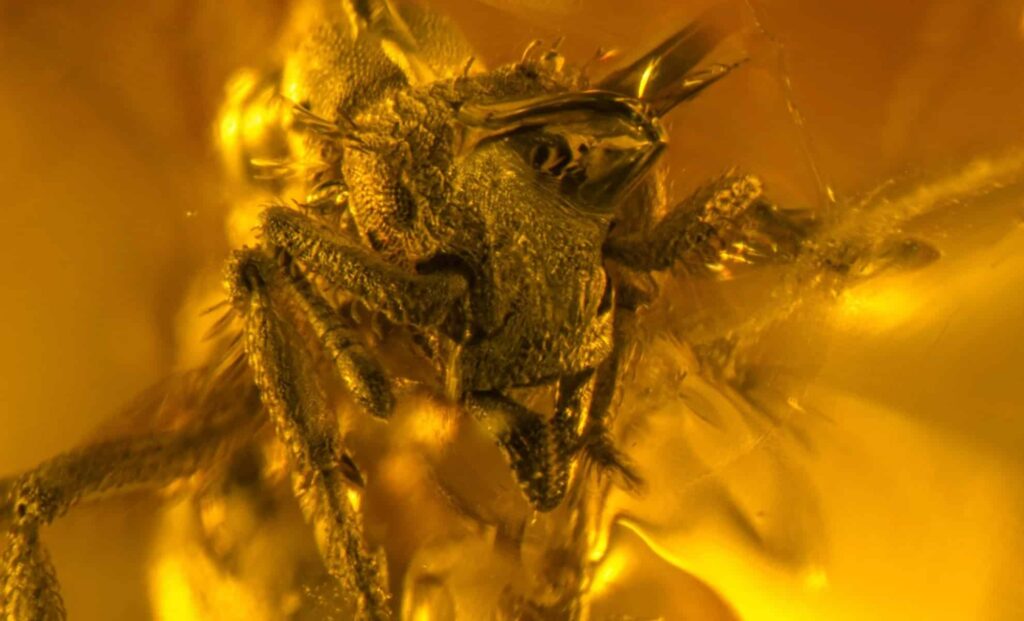Unveiled in a new study published in Proceedings of the Royal Society B, the fossil is the smallest known member of its genus. Its unique features reveal that this now-vanished group once inhabited regions far outside its current range and had already developed advanced camouflage mechanisms long before modern ecosystems emerged.
The fossil was found in Dominican amber dating back to the Miocene epoch, a period marked by dramatic shifts in sea levels and habitat ranges. This specimen confirms that the now-island-absent Basiceros once lived in the Caribbean, tightening the timeline of its disappearance and pointing to a more complex evolutionary past than previously known.
Fossil Reveals Early Camouflage Evolution
The fossil of Basiceros enana, preserved with remarkable detail, provides key information about the evolution of camouflage strategies. Its body is covered in two distinct types of setae—tiny bristles that serve to trap and hold particles like soil and leaves. This allows dirt ants to disappear into the forest floor, a technique known as crypsis.
These bristles are divided into longer brush hairs, which collect debris, and shorter holding hairs that press the particles flat against the ant’s exoskeleton. This adaptation is still seen in modern relatives and, according to lead scientist Gianpiero Fiorentino of the New Jersey Institute of Technology, proves that “the stealthy camouflage toolkit was already in place long before humans existed.”
To study the fossil without damaging it, the research team used micro-CT scans that captured delicate structural details hidden beneath the amber. This approach allowed them to observe physical traits such as mandibles, body spines, and leg structures that clearly situate Basiceros enana within the predatory, ground-dwelling dirt ants.

Shifting Geographic Range Alters Understanding of Ant Lineage
Until now, Basiceros ants were believed to inhabit only Central and South America. The discovery of Basiceros enana in the Dominican Republic drastically alters that assumption. It confirms that the genus once extended into Caribbean island ecosystems, only to vanish later—likely due to extinction pressures during or after the Miocene.
According to Earth, the fossil marks a rare island record of a group otherwise absent from current Caribbean faunas. The ant’s presence on the island offers new data points for the study of biogeography, showing that Basiceros had a broader range than previously thought and that its disappearance may have been part of a larger regional extinction pattern tied to rising seas and shrinking habitats.
There is ongoing debate about how ants such as Basiceros originally colonized the Caribbean. Some researchers point to temporary land bridges, while others consider storm-driven dispersal or drifting vegetation mats as more plausible explanations. What is now certain is that Basiceros enana lived—and disappeared—from an island ecosystem that has since transformed dramatically.
Smallest Known Specimen Shifts Theories on Body Size Evolution
The fossilized worker ant measures only 0.20 inches in length, making it the smallest recorded member of the Basiceros genus. This contradicts earlier theories suggesting the genus began large and later underwent size reduction. Instead, the study suggests the opposite—that body size increased over time from an initially small ancestor.
The fossil also displays anatomical details that fit the Basiceros profile, including triangular mandible teeth suited for hunting and a small spine at the rear of the thorax that connects internal muscle structures. Features like its head shape and leg segments helped confirm its place on the ant’s family tree.
The presence of a predatory, well-camouflaged species in a now-vanished ecosystem offers an important glimpse into ancient ecological dynamics. Each fossil of this kind not only adds to the evolutionary record but also underlines how sensitive specialized predators are to environmental shifts.
The rarity and condition of this fossil make it a singular find. “Finding one today is exciting given how well they stay hidden,” said Fiorentino. “But captured in amber, it’s like finding a diamond.”

